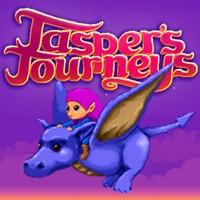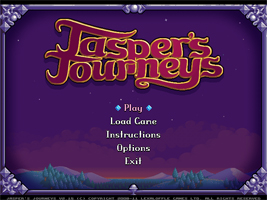

developed by Lexaloffle Games (Wellington, New Zealand)
original DOS version released 1997
present version first published February 14, 2008, for Windows/Mac, $19.95
[trailer]
[website]
[play the entire game in your browser!]
~30 MB
Played to completion in 7.5 hours, 3/11/15–3/18/15.
[30-minute video of the first half of the game. (The only complete playthrough on YouTube is this 2.5-hour one in three parts, which has oppressively heavy player babble throughout.)]
Fifth of the seven games in the “Humble Voxatron Debut,” purchased November 9, 2011.
Everything about this game comes out of the past, but I’m not sure it can be called nostalgia. It seems to have been made in a spirit of genuine anachronism, which suits me fine.
Jasper’s Journeys overtly resembles games from the early 90s, games that I played, but it doesn’t actually depend on the player tapping into those memories; it just creates the same effect those games did. If you visit the same place 20 years apart, you aren’t taking a trip into the past. The place is continuously in the present.
This was another theme covered in that videogame book I drafted: games live eternally and don’t age, so they frustrate nostalgia even as they court it. Boot up Super Mario Bros. and you will see exactly the same thing you saw 30 years ago, which is to say you will not see the passage of time, or yourself, or anything else that’s necessary to sustain a sense of loss. Mario is responding to what you are doing only in this moment, always. Even movies leave more room for dreaming about one’s past viewings, because they go all by themselves. Games don’t; for them to work we need to be in them, which is why we can’t also be in our memories.
When Jasper’s Journeys was first made (by teenagers) in 1996 or so, it was imitative of trends from a few years earlier, as so many amateur productions are. We don’t tend to call that “retro.” When it was revamped in 2008, none of the essential aesthetic choices from the original were changed, because the designer’s tastes hadn’t changed. Since more cultural time has passed, it now becomes “retro” (and he advertises it as such), but really it’s the same thing it always was.
A lot of my fond memories of computer games from my childhood revolve around their eerie selfhood-erasing atmosphere, somewhere between hypnosis and fun. From our present vantage point, it’s tempting to look back at those games and say that a lot of that atmosphere was inadvertent, that it arose from technological limitations and naive aesthetic choices; after all, most of them were designed by technicians rather than artists. But I think that’s wrong. Pop culture in the 80s was full of surreal, somnambulistic stuff; think of all those spacey synthesizers in the pop music of the era. Games that induced a mild spooky trance knew exactly what they were doing, I say. (Hm. This was yet another whole chapter of my book, which again I’d rather not completely repeat/give away here.)
My point is that this game knows what it’s doing, and I put it to you that it’s exactly the same thing its forebears were doing. So it’s like a game from 1992, except a little softer and more polished in some ways.
The very sparse use of music creates an excellent effect, calling attention to the pregnant possibilities of silence. The general absence of music becomes dreamy and ominous. This effect does indeed remind me of Commodore 64 days — but only because I haven’t seen it used since then, not because it is somehow anchored to the 80s or to my childhood. I like it now too. More developers should take note!
To belabor this point further: this is not nostalgia; just the opposite. Nostalgia is an excuse to not learn from the past, because it’s so wrapped up in its pastness. Actually resembling the past means erasing the difference between now and then, which for some psychologies is undesirable. “Retro” fashions are almost always fueled by a smug sense of superiority over the past from which they borrow — undeserved, of course. The idea that we do not actually have any real leg up on the people of the past — that they were not “adorable, but wrong about a lot of things” but were, in fact just like us — can be a hard pill to swallow for a lot of people. I’m actually not sure why. Perhaps because the people of the past are dead, so we’re afraid to see ourselves sitting next to them in the Haunted Mansion mirror?
Anyway, I’m saying that this game has some of that magical subterraneanity I mentioned a few entries ago. This time I’m certain it’s deliberate, and I admire that. I also appreciate that the level design — which really is the soul of most games — has been done with care so that everything counts: secret passages to huge underground chambers; roundabout secondary routes; glimpses of treasure rooms on the very edges of the screen, out of reach; hidden worlds in the clouds directly above the place where you start but accessible only after obtaining the high-jump potion from far away. Large spaces that make the frame of the screen feel like a small bubble against the wide world; a constant sense of pushing outward, exploring, earning new information.
So in terms of feel, spirit, and space, this was something quite charming. And yet there was also a thinness to it, as though it wasn’t really a real game, just someone’s project. Chocolate Castle, by the same developer, had a very similar anachronistic look and feel, but it was also made up of new and excellent puzzles. Jasper’s Journeys is just made up of the stuff it looks like. It’s like the gameplay itself is just another part of this exercise in evoking certain mysterious feelings. And it does evoke those feelings; it just doesn’t do anything much as a game.
The game refuses to be given too much attention. The plot is that you’re an elf or something, and a witch kidnapped your cat. That’s it. At the end the final boss is the witch on a broomstick; otherwise it’s just a bunch of platformer worlds and platformer enemies: jump, get coins, get “fruit,” don’t touch monsters. This constitutes a kind of intentional, affectionate emptiness, which is quaint but also genuinely empty. So there’s a limit on how much I can get out of a thing like this. This is sort of a homey poem, so it ought to be short like a poem. I would have liked to spend about 3 hours with this game rather than 7. It probably didn’t need to be 15 levels long and brimming-full of “secrets” that seemed to need discovering.
But ultimately, even that was okay. The game had the great virtues of being gentle-hearted and, to borrow a word that another site used to describe this developer, earnest. That’s an apt description of the impression the game makes: it is a watery trifle, but made by someone who really cares about watery trifles and has thought a lot about their value.
I’m a big fan of earnestness, which is different from seriousness.
Somehow, this 30 MB game has been packed into a 2 MB zip file for distribution. The main data file is packed at a 92% compression ratio. I’ve never seen such a thing before and have no idea how it was done.
Credits as they appear in the game:
Joseph White: Code, Music
John White: Graphics, Map Design
Tomas Pettersson: Sound
I watched a little of the video of the game being played and saw that it was the kind of game I would play. Due to what? Its earnestness? Retro-ness? Simplicity? Emptiness? It reminded me of some of what appealed to me in playing the electronic slot machines in Las Vegas, which seemed to be based on surrendering to an endeavor that allows for the cessation of thinking. Or maybe “requires,” more than allows for. And maybe not “surrendering.” But it offers a kind of place-holder for thinking that has a particular appeal. Make of that what you will.
And then saw that I COULD play it, from your link. And then, Jasper preserve me, I played. A little. I am not very skilled with the controls, so I lost pretty quickly. And luckily for me, that was an easy exit point.